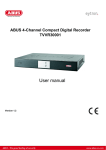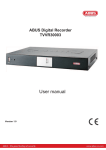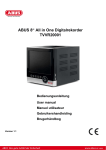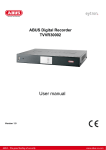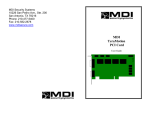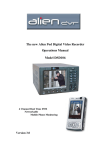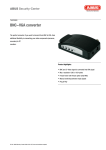Download User manual
Transcript
ABUS 8” Combo Digital Recorder TVVR20000 User manual Version 1.1 Notes on the operating instructions Deutsch Nederlands Diese Bedienungsanleitung enthält wichtige Hinweise zur Inbetriebnahme und Handhabung. Achten Sie hierauf, auch wenn Sie dieses Produkt an Dritte weitergeben. Heben Sie deshalb diese Bedienungsanleitung zum Nachlesen auf! Eine Auflistung der Inhalte finden Sie im Inhaltsverzeichnis mit Angabe der entsprechenden Seitenzahlen. Deze gebruiksaanwijzing hoort bij dit product. Er staan belagrijke aanwijzingen in betreffende de ingebruikname en gebruik, ook als u dit product doorgeeft aan derden. Bewaar deze hendleiding zorgvuldig, zodat u deze later nog eens kunt nalezen! U vindt een opsomming van de inhoud in de inhoudsopgave met aanduiding van de paginanummers. English Dansk These user manual contains important information for installation and operation. This should be also noted when this product is passed on to a third party. Therefore look after these operating instructions for future reference! A list of contents with the corresponding page number can be found in the index. Denne manual hører sammen med dette produkt. Den indeholder vigtig information som skal bruges under opsætning og efterfølgende ved service. Dette skal huskes også når produkter gives videre til anden part. Læs derfor denne manual grundigt igennem også for fremtiden. Indholdet kan ses med sideanvisninger kan findes i indekset. Français Ce mode d’emploi appartient à de produit. Il contient des recommandations en ce qui concerne sa mise en service et sa manutention. Veuillez en tenir compte et ceci également lorsque vous remettez le produit à des tiers. Conservez ce mode d’emploi afin de pouvoir vous documenter en temps utile! Vous trouverez le récapitulatif des indications du contenu á la table des matières avec mention de la page correspondante. Pay attention to the accompanying documents on “Control via the web interface” and “Software”. These can also be found on the Internet under www.abus-sc.com 2 Device overview Device overview See System operation on page 12. Front 8 1 2 3 4 5 6 7 Rear 9 10 11 12 13 14 15 3 Device overview Remote control 4 Contents Device overview ...............................................................................................................................................................3 Quick guide ......................................................................................................................................................................7 Before you start................................................................................................................................................................7 Installing the HDD ............................................................................................................................................................7 Establishing the connections ...........................................................................................................................................7 Important safety information ..........................................................................................................................................8 Explanation of symbols ....................................................................................................................................................8 Proper use .......................................................................................................................................................................8 General ............................................................................................................................................................................8 Power supply ...................................................................................................................................................................8 Overloading/Overvoltage .................................................................................................................................................9 Cables ..............................................................................................................................................................................9 Installation location/Operating environment ....................................................................................................................9 Remote control.................................................................................................................................................................9 Care and maintenance...................................................................................................................................................10 Accessories ....................................................................................................................................................................10 Putting into operation .....................................................................................................................................................10 Children and the device .................................................................................................................................................10 Introduction ....................................................................................................................................................................11 General information .......................................................................................................................................................11 Unpacking the device.....................................................................................................................................................11 Scope of delivery ...........................................................................................................................................................11 System operation ...........................................................................................................................................................12 General information .......................................................................................................................................................12 Operating elements on the device .................................................................................................................................12 Connections on the rear of the device ...........................................................................................................................12 Operating elements on the remote control ....................................................................................................................13 Mouse operation ............................................................................................................................................................13 Starting the device .........................................................................................................................................................14 On-screen keyboard ......................................................................................................................................................14 Displays on the monitor .................................................................................................................................................14 Live view .........................................................................................................................................................................15 Overview ........................................................................................................................................................................15 Pop-up menu for mouse operation ................................................................................................................................15 Settings ..........................................................................................................................................................................15 Setting the date/time .................................................................................................................................................16 Setting the preview ...................................................................................................................................................16 Record .............................................................................................................................................................................17 Set-up.............................................................................................................................................................................17 Schedule ...................................................................................................................................................................18 Manual record ................................................................................................................................................................18 Playback..........................................................................................................................................................................19 General information .......................................................................................................................................................19 Using the control panel .............................................................................................................................................19 PTZ control .....................................................................................................................................................................20 General information .......................................................................................................................................................20 Using the PTZ control panel .....................................................................................................................................20 Pop-up menu for mouse operation ...........................................................................................................................20 PTZ settings ..............................................................................................................................................................20 Preset settings ...............................................................................................................................................................21 5 Contents Patrol settings ................................................................................................................................................................21 Pattern settings ..............................................................................................................................................................22 Device menu ...................................................................................................................................................................23 Menu overview ...............................................................................................................................................................23 Menu description ......................................................................................................................................................23 Live view ........................................................................................................................................................................24 Camera ..........................................................................................................................................................................24 Motion detection: Setting an area .............................................................................................................................24 Motion detection: Settings ........................................................................................................................................24 Advanced settings ....................................................................................................................................................25 Recording .......................................................................................................................................................................25 Network ..........................................................................................................................................................................25 General .....................................................................................................................................................................25 Terms and definitions ...............................................................................................................................................25 Network layout ..........................................................................................................................................................26 Network configuration ...............................................................................................................................................26 Alarms ............................................................................................................................................................................29 PTZ ................................................................................................................................................................................30 Users ..............................................................................................................................................................................30 Utilities............................................................................................................................................................................31 Troubleshooting .............................................................................................................................................................32 Index ................................................................................................................................................................................33 Technical data ................................................................................................................................................................34 HDD storage capacity ...............................................................................................................................................35 Disposal ..........................................................................................................................................................................36 Information on the EU directive on waste electrical and electronic equipment .............................................................36 Information on handling batteries ..................................................................................................................................36 Important information on disposing of batteries .............................................................................................................36 Information on the European RoHS directive ................................................................................................................36 Glossary ..........................................................................................................................................................................37 Overview of specialist terms ..........................................................................................................................................37 Internal HDD ...................................................................................................................................................................39 6 Quick guide Quick guide Before you start The following preparatory steps must be made: 1. Pay attention to the general information, safety information and notes on setting up and connecting the device (see page 8). 2. Check the contents of the package for completeness and damage. 3. Insert the batteries into the remote control. Installing the HDD Warning Switch off the device and disconnect it from the mains power supply. Pay attention to the required earthing of the device to avoid static discharge. 1. Install the HDD. Use the data and power cable supplied. 2. Firstly, establish the connection to the motherboard using the red data cable (small connector). 3. Connect the power supply cable (large 5-pin connector). 4. Check that the connections are secure. 5. Close the housing. Establishing the connections 1. Connect the analogue cameras with BNC connections 1 to 4. 2. Connect the audio connections. 3. Connect the LAN connection on the device to the network. 4. Connect the sensors to the alarm inputs. 5. Connect the monitor to the BNC connection. 6. Connect the mouse to the USB port. 7. Establish a connection to the mains power supply. 8. Switch on the device using the POWER switch on the rear. The DVR status display on the front of the device lights up. Note To connect a monitor with a VGA connection, use the BNC-VGA converter (TVAC20000). 7 Important safety information Important safety information Explanation of symbols General The following symbols are used in this manual and on the device: Before using the device for the first time, read the following instructions carefully and pay attention to all warnings, even if you are already familiar with electronic devices. Symbol Signal word Meaning Warning Warning Indicates a risk of injury or health hazards. Warning Indicates a risk of injury or health hazards caused by electrical voltage. All guarantee claims become invalid for damage caused by non-compliance with these operating instructions. We cannot be held liable for resulting damage. Warning Important Indicates possible damage to the device/accessories. Note Indicates important information. The following labels are used in the text: Meaning 1. … 2. … • … • … We cannot be held liable in the event of material or personal damage caused by improper operation or non-compliance with the safety information. Set of tasks or instructions with a defined sequence in the text Set of points or warnings without a defined sequence in the text All guarantee claims are invalid in such cases. Keep this manual in a safe place for future reference. If you pass on or sell the device, you must also include this user manual. This device has been manufactured in accordance with international safety standards. Power supply Proper use Only use the device for the purpose which it was designed and built for. Any other use is considered inappropriate. • Only operate this device through a power source which supplies the mains power specified on the type plate. • If you are unsure of the power supply at the installation location, contact your power supply company. This device may only be used for the following purpose(s): • Warning This digital recorder is used in combination with connected video signal sources (B/W and colour cameras) and video output devices (CRT or TFT monitors) for object surveillance. Avoid data loss! Always use an uninterruptible power supply (UPS) with overvoltage protection. Note • Data storage is subject to national data-protection guidelines. Disconnect the device from the mains power supply before carrying out maintenance or installation work. • During installation, inform your customers regarding the existence of these guidelines. The on/off switch does not completely disconnect the device from the mains power supply. • To disconnect the device completely from the mains power supply, the plug must be disconnected from the mains socket. Therefore, the device should be positioned so that direct and unobstructed access to the mains socket is guaranteed at all times and the plug can be disconnected immediately in an emergency. • To avoid the possibility of fires, the plug should always be disconnected from the network socket if the device is not used for long periods. Disconnect the device from the mains power supply before impending electrical storms, or use an uninterruptible power supply. 8 Important safety information Warning Never open the device on your own! There is a risk of electric shocks! If it is necessary to open the device, consult trained personnel or your local maintenance specialist. • • Operating temperature and ambient humidity: -10 °C to 55 °C, maximum 85 % relative humidity. The device may only be operated in moderate climate conditions. Ensure the following: • Sufficient ventilation must be present at all times (do not place the device in a storage rack, on thick carpets, on a bed or anywhere where the ventilation slots are covered. Make sure that a gap of at least 10 cm is present on all sides). • The device must not be exposed to direct heat sources (e.g. heaters). • The device must not be exposed to direct sunlight or strong artificial light. • The device must not be placed in close proximity to magnetic fields (e.g. loudspeakers). • Naked flames (e.g. candles) must not be placed on or near the device. • Contact with spraying or dripping water and aggressive liquids must be avoided. • The device must not be operated in close proximity to water, and must not be submerged under any circumstances (do not place objects containing water on or near the device, such as vases or drinks). • Foreign objects must not penetrate the device. • The device must not be exposed to strong variations in temperature, as this can lead to condensation and electrical short circuits. • The device must not be exposed to excessive jolts or vibrations. The installation or modification of a HDD should only be made by trained personnel or your local maintenance specialist. Warning The installation of additional equipment or modification of the device invalidates your guarantee if not carried out by trained personnel. We recommend having the HDD installed by a maintenance specialist. Your guarantee is invalidated in the event of improper installation of the HDD. Overloading/Overvoltage • Avoid overloading of mains sockets, extension cables and adapters as this can result in fires or electric shocks. • Use overvoltage protection to prevent damage caused by overvoltage (e.g. electrical storms). Cables • Always hold cables by the connector, and do not pull the cable itself. • Never touch the mains cable with wet hands, as this can lead to a short circuit or electric shock. • Never position the device, furniture or other heavy items on the cable. Ensure that the cable does not become kinked, especially on the connector and sockets. • Never knot the cable, and do not tie it to other cables. • All cables should be laid so that they cannot be stepped on or cause an obstruction. • A damaged mains cable can cause a fire or electric shock. Check the mains cable from time to time. • Never modify or manipulate the mains cable or plug. • Do not use plug adapters or extension cables that do not conform to the applicable safety standards, and do not make alterations to power supply cables or mains cables. Remote control • Remove all batteries if the device will not be used for a sustained period, as these can leak and damage the device. Installation location/Operating environment • Position the device on a firm, level surface and do not place any heavy objects on the device. • The device is not designed for operation in rooms subject to high temperatures or moisture (e.g. bathrooms), or in excessively dusty rooms. 9 Important safety information Care and maintenance Putting into operation Maintenance is necessary if the device has been damaged. This includes damage to the plug, mains cable and housing, penetration of the interior by liquids or foreign objects, exposure to rain or moisture or when the device does not work properly or has fallen. • Observe all safety and operating instructions before putting the device into operation for the first time. • Only open the housing to install the HDD. • Disconnect the device from the mains power supply before maintenance (e.g. cleaning). • If smoke develops or unusual noises or odours are detected, then switch off the device immediately and pull the mains plug from the socket. In such cases, the device should not be used until it has been inspected by a qualified technician. • Maintenance work should only be carried out by qualified specialists. • Never open the housing on the device or accessories. There is a risk of fatal injury due to an electric shock when the housing is opened. • Clean the device housing and remote control with a damp cloth. • Do not use solvents, white spirit or thinners as these can damage the surface of the device. • Do not use any of the following substances: • Salt water, insecticides, solvents containing chlorine or acids (ammonium chloride) or scouring powder. • Gently rub the surface with a cotton cloth until it is completely dry. Warning When installing the device in an existing video surveillance system, ensure that all devices are disconnected from the mains power supply and low-voltage circuit. Warning If in doubt, have a specialist technician carry out assembly, installation and connection of the device. Improper or unprofessional work on the mains power supply or domestic installation puts both you and other persons at risk. Connect the installations so that the mains power circuit and low-voltage circuit always run separately from each other. They should not be connected at any point or become connected as a result of a malfunction. Children and the device • Do not allow children access to electrical devices. Never allow children to use electrical devices without supervision. Children may not be able to accurately detect possible risks. Small parts can be lifethreatening if swallowed. • Keep batteries away from small children. Call for medical assistance immediately if a battery is swallowed. • Keep packaging materials away from children (danger of suffocation). • This device should not be used by children. If used improperly, spring-loaded parts can be ejected and cause injuries to children (e.g. eye injuries). Warning The device works under dangerous voltages. The device must only be opened by authorised specialists. All maintenance and service work must be carried out by authorised firms. Improper repairs can expose device users to the risk of fatal injury. Accessories • 10 Only connect devices that are suitable for the intended purpose. Otherwise, hazardous situations or damage to the device can occur. Introduction Introduction Dear customer, Thank you for purchasing this product. This product complies with current domestic and European regulations. Conformity has been proven, and all related certifications are available from the manufacturer on request (www.abus-sc.com). To maintain this status and to guarantee safe operation, it is your obligation to observe these operating instructions! Read the entire operating manual carefully before putting the product into operation and pay attention to all operating and safety information! All company names and product descriptions are trademarks of the corresponding owner. All rights reserved. In the event of questions, please contact your local maintenance specialist or dealer. Disclaimer These operating instructions have been produced with the greatest care. Should you discover any missing information or inaccuracies, please contact us under the address shown on the back of the manual. ABUS Security-Center GmbH does not accept any liability for technical and typographical errors, and reserves the right to make changes to the product and operating instructions at any time and without prior warning. ABUS Security-Center GmbH is not liable or responsible for direct or indirect damage resulting from the equipment, performance and use of this product. No forms of guarantee are accepted for the contents of this document. General information In order to use the device correctly, read this user manual carefully and keep it in a safe place for later use. This manual contains instructions on recorder operation and maintenance. Consult an authorised specialist if the device needs to be repaired. 11 Unpacking the device Handle the device with extreme care when unpacking it. The packaging is made of reusable materials, and should always be passed on for recycling. We recommend the following: Paper, plastic packaging, cardboard and corrugated cardboard should be disposed of in the appropriate recycling containers. If recycling containers are not available in your local area, then you can dispose of these materials as domestic waste. If the original packaging has been damaged, inspect the device. If the device shows signs of damage, then return it in the original packaging and contact the manufacturer. Scope of delivery • ABUS Digital Recorder • Power supply unit and mains cable • Remote control (without batteries) • Connection cable for HDD • Software CD • User manual System operation System operation General information Connections on the rear of the device The device can be controlled as follows: • By remote control • Using the USB mouse Operating elements on the device Note Pay attention to the overview on page 3. No. Note Pay attention to the overview on page 3. 7 Name Function Navigation buttons: Move within the menu OK: No. 1 2 3 4 5 6 Name Function IR receiver For the remote control 1: Switch to camera input 1 2: Switch to camera input 2 3: Switch to camera input 3 4: Switch to camera input 4 M Opens or exits menu • Confirm in menu • 8 9 10 11 12 13 Press and hold for 5 seconds in live view to activate or deactivate key lock USB port • To connect a USB mouse • To connect a USB stick for data backups VIDEO IN: BNC inputs VIDEO OUT 1: BNC monitor output VIDEO OUT 2: BNC spot monitor output AUDIO IN: Cinch audio input AUDIO OUT: Cinch audio output LAN: 10/100 MBit Ethernet LAN connection ALARM IN: • Alarm input 1–4 • G = Ground ALARM OUT: • Relay output and ground RS-485: 14 Connection for PTZ cameras 12 V DC power socket 15 Power switch 12 System operation Operating elements on the remote control 34 Focus+: In PTZ mode: • Enlarges the image section in PTZ mode No. Name Function Not used Not used PTZ Switches on PTZ control Enter key fII • Confirms the selection • Ticks/unticks the boxes During playback: • PLAY/PAUSE MENU • Calls up the main menu • Switches the key tones on and off (press and hold down for 5 seconds) REC Opens/starts manual recording Not used Deletes character during entry Note Pay attention to the remote control diagram on page 4. No. Name Function 16 POWER On/Off switch DEV Assigns the remote control with the device ID Alphanumeric keys • For selecting the camera (channel) in the live view • For entering letters and digits in system fields A • Changes the entry format (upper/lower case, symbols, digits) • Further symbols can be displayed by pressing the “0” button in symbol mode. PLAY Starts playback VOIP Not used PREV Changes the screen display in the live view Navigation keys During playback: • S, TSets the speed • W, XPrevious/next day In PTZ: • Camera control In menus: • Navigation ESC • Exits menu Not used Not used Zoom +: Enlarges the image section in PTZ mode F1: Not used Zoom -: Reduces the image section in PTZ mode F2: Not used IRIS-: In PTZ mode: • Closes the iris Focus-: In PTZ mode: • Reduces the image section in PTZ mode IRIS+: In PTZ mode: • Opens the iris 17 18 19 20 21 22 23 24 25 26 27 28 29 30 31 32 33 35 36 37 38 39 40 41 42 Mouse operation Note Further descriptions in these operating instructions can be accessed with the mouse. The device is suitable for use with a USB mouse. Connect the mouse to the USB port. Button Function Left Single-click • Selection in menu, activation of an entry field or tab Double-click • Switches between the screen display of single and multiple images in the live view and during playback Click and drag • Right Scroll wheel In PTZ mode: Camera control • Set-up of alarm areas or zones Single-click • Calls up the pop-up menu In full-screen live view • Shows previous/next camera In menus: • Selects/changes settings 13 System operation Starting the device Important The device must only be operated with the mains power specified on the type plate. For safety reasons, use an uninterruptible power supply (UPS). After the device has been connected to the power supply and the main switch on the rear of the device is switched on, the power LED lights up. The device carries out a self-test during the start-up procedure. On-screen keyboard The on-screen keyboard appears after clicking on a text entry field with the mouse: The keys have a similar function as on a mobile phone. • Each key has more than one character. • Pressing the “A” key scrolls through the following modes: - Numbers - Uppercase - Lowercase - Special characters (press the “0” key to display further symbols) • Press the same key repeatedly to get the character you require. • To delete the character in front of the cursor, click on “EDIT”. Displays on the monitor The device shows the date and time, camera name and whether a recording is in progress. • Continuous recording: Blue “R” • Event recording: Red “R” Password Warning Note down the admin password. The following password is preset “1 2 3 4 5” 14 Live view Live view Overview Settings The live view starts automatically after the device is switched on. The signals of the connected cameras are displayed on the main screen. • Note The live view can be set as follows. Open the main menu and click on Display: By double-clicking the left mouse key, you can display the camera image as a full-screen view or switch back to the original view. Pop-up menu for mouse operation Note Press the right mouse button when the cursor is positioned on a live image. The following settings can be made. The arrow pointing to the right indicates that a sub-menu is opened for selection: Single Full-screen view for selected camera Mult Preview 4x camera view Next Preview Displays the next camera in fullscreen view PTZ Control Activates PTZ mode Play Switches to playback mode Manual Record Starts/finishes recording Close Status Opens/closes the recording status symbol Aux Chan Displays camera on the Aux chan Main menu Opens the main menu Language User interface language Device ID Used for unique identification when using remote control Require Password Activates/deactivates password prompt (when accessing via the network, the password is still needed despite deactivation) Screen Saver: Sets the time of inactivity after that the monitor is turned off. Video Standard PAL/NTSC Menu Transparency Date/Time Transparency of the main menu Preview Stop Auto-switch, camera identification Time, date and DST 15 Live view Setting the date/time Date Display Mode Date DD/MM/YY, MM/DD/YY, YY/MM/DD Time To enter the hour, minute and second Enable DST Daylight Saving Time Bias: Correction of the DST to the reference time From DST starts To DST ends To enter the day, month and year Setting the preview Preview Default setting in the preview: Full-screen, 4x view Switch Time Switch time between the cameras in the full-screen view: Never, 5 seconds .. 30 minutes Audio Preview Audio output during the full-screen view Display Delay Time the triggering camera is displayed as a full-screen image if an event occurs Layout Changes the camera layout in the preview 16 Record Record Set-up Note Open the main menu and click on Record: In addition to these settings, the schedule must be configured to start a recording. Note The maximum PreRec/PostRec time is dependent on the set bit rate. The lower the bit rate, the more memory is available for PreRec/PostRec. If HDD Full Select Camera Enable EventPara Stream 1/ Stream 2 Stream Type Resolution Frame Rate Bit Rate Enable Rec PostRec Time PreRec Time Copy to Camera 17 Overwrites or finishes recording Camera to be set Select this item to record events (motion detection or alarm) Stream 1 = Parameter for continuous recording Stream 2 = Parameter for event recording Video, video and audio QCIF, CIF Number of images saved per second. The maximum number is dependent on the set resolution. Data volumes per second. The recommended bit rate is set for each resolution. A bit rate lower than that recommended reduces the recording quality but extends the recording time. Activates/deactivates camera recording Recording period after an alarm (in seconds) Recording period before an alarm (in seconds) Copies the selected settings to other cameras (all or selected) Record Schedule The schedule is used to specify the recording times and triggers (recording type) for the cameras. Click on Schedule: 1. Select “Manual Record” in the live view: 2. Select the camera to start manual recording. Click on “Start/Stop” to do so. Note I 1. Select the day. 2. Tick or untick the “All Day” box. When “All Day” is selected, defined times cannot be entered. The recording type then applies to the entire day. 3. Specify the recording type in the drop-down menu: • All Day • Motion detection • Alarm • Motion detection or alarm • Motion detection and alarm 4. To make specific time settings, untick the “All Day” box. 5. When making a specific time setting, you can define up to 4 time periods (each from 00:00 to 00:00). The times in the individual periods must not overlap. 6. Select the camera under “Copy to” or select “All”, then confirm by pressing “Copy”. Note With All Day, you define time windows where there is continuous recording. The other events (e.g. motion detection and/or alarm) only trigger the recording after the specific event has occurred. 18 Manual record Click on “Start All” or “Stop All” to start or finish recording from all the connected cameras. Playback Playback General information 1. Select “Play” in the live view. Using the control panel The control panel is used for controlling the running playback. The symbols have the following meaning: 1 2 3 4 5 6 7 8 9 10 11 No. Meaning/function 1 Reverses 30 seconds 2. To search for existing recordings, select the camera, recording type and time period. 3. Click on “Search” to search for relevant recordings. If there are more than 8 search results, they are listed on additional pages. Scroll through the pages by pointing the mouse on the front page number and turning the scroll wheel. 4. Select one or more entries and click on “Play” to play them back. 5. Click on “Copy” to back up the selected entries on USB or “Backup Today” to back up the entire day. Note Data backup: After you start copying, the message “Waiting for USB medium...” appears. Now remove the USB mouse and connect a USB medium to back up the data. Copying starts automatically. You can also use the remote control supplied for the recorder at any time. 19 2 Reduces the playback speed 3 Playback/Pause 4 Increases the playback speed 5 Advances 30 seconds 6 Switches audio playback on/off 7 Saves the recording 8 Hides the control panel 9 Digital zoom 10 Previous camera 11 Next camera Note Data backup: If you press the “Save recording” button, the video currently being shown is saved temporarily until the button is pressed again. You can repeat this procedure as many times as you wish. After exiting Playback, you are prompted to back up on a USB medium the videos saved temporarily. If the videos are not backed up immediately after exiting Playback, they are deleted. PTZ control PTZ control General information PTZ control is used to access individual PTZ cameras and control them manually. PTZ settings The following settings are necessary on the PTZ cameras: Using the PTZ control panel 1 2 3 4 No. Meaning/function 1 Iris 2 Focus 3 Zoom 4 Controls camera and starts patrol 1 1. Select the installed camera. 2. Enter the data of the connected camera. Ensure that the data matches that of the PTZ camera. 3. The PTZ ID is used to clearly identify and control the PTZ camera. 4. If several cameras of the same type are connected, then you can copy the settings to the other connections. 5. Exit the settings by pressing Apply and OK. Pop-up menu for mouse operation Note Press the right mouse button when the cursor is positioned on a live image. The following settings can be made. The arrow pointing to the right indicates that a sub-menu is opened for selection: Channel PTZ camera selection Preset Selects the set preset Exit Exits PTZ mode Note Check the settings of the PTZ cameras. If a connected camera does not work correctly, then check the entered parameters (ID, baud rate, data bit etc.). 20 PTZ control Preset settings Patrol settings Presets are previously defined locations of a PTZ camera. Various positions can be defined for each PTZ camera. The cameras can then pan and tilt quickly to the corresponding locations. Patrols are defined tours from position to position that are accessed in sequence on the PTZ camera. The individual positions are presets, which should be set as detailed before. The cameras can then each be moved in sequence to the corresponding positions at a defined speed, where they remain for a set period of time. • Select PTZ in the menu and click on Preset Settings: 1. Select a preset number between 1 and 128. 2. Select Adjust to change the position of the camera. 3. Right-click to exit the PTZ control and click on Save to store the Preset position. 4. Repeat steps 1–3 to define further presets. 5. Finish your settings by pressing Return. • Select PTZ in the menu and click on Patrol Settings: 1. Press Start Setting. 2. Select patrol no. 1. 3. At Add KeyPoint, select a KeyPoint and assign a preset to it. 4. Set the duration and speed. • Patrol Preset: Sequence • Duration: Time that the PTZ camera waits at a position (in seconds) • Speed: Start-up speed 5. Accept the settings by pressing Confirm. 6. Exit the settings by pressing OK. Note A patrol consists of at least two preset positions. You can set several patrols for one camera. The set patrol can be tested as follows: Click on StartSeq and monitor the patrol. You can stop the patrol at any time by pressing EndSeq and repeat the patrol settings (e.g. to make corrections). 21 PTZ control Pattern settings Patterns are defined tours from position to position that are accessed in sequence on the PTZ camera. Patterns are recorded almost live. The system saves the parameters used whilst you move and adjust the cameras in sequence to the corresponding positions at a defined speed. • Select PTZ in the menu and click on Pattern Settings: 1. Click on Rec Pattern to start the pattern recording. 2. Using the control panel, adjust the camera position and settings that you wish to record as a pattern. 3. The recording is made until you right-click to finish the recording. Note 22 • Start the recorded pattern by calling up the pop-up menu (right-click in the live view of the PTZ camera). • Click on Set Pattern and click on the desired pattern. The PTZ camera now starts moving to the individual positions. After running through the entire pattern, the process is started again. Device menu Device menu Menu overview • Click on a menu to open it. The following overview shows all menus used to set and control the device. • Right-click to close the menu overview. Menu description Menu Description Display Settings that affect the display Camera Camera name-specific settings, motion detection, video signal loss, tamper settings Recording Recording parameters and schedule Network Network, e-mail, DDNS and PPOE settings Alarms Alarm input and output settings PTZ PTZ camera settings User User administration Utilities Load default setting, firmware upgrade, HDD management, switch alarm output, restart/shut down recorder, log search and system info 23 Device menu Live view Note See also the description on page 24. Motion detection: Setting an area Camera Select Camera Camera selection Name Camera names. Select position in the live image. Color Choose settings to adjust the brightness, contrast, colour hue and saturation of the camera image. Date OSD Display type and position in the live image. Motion Det. Level This sets the sensitivity of the motion detection. The more “+” there are, the more sensitive the motion detection. Select Area to define a motion detection mask and Policy to set the reaction of the recorder after motion is detected. Advanced Privacy mask, video signal loss and tampering. Copy to Camera Copies the settings. 24 1. Press and hold down the left mouse button and select using red boxes the area to be detected. 2. Right-click to simply set full-screen detection or to exit the menu. Motion detection: Settings Record Chan. Select a camera for recording. Schedule Select the period to which the settings apply. On Screen Warning Triggering camera is displayed in fullscreen mode. Upload to Center Notifies a PC with the ABUS DVR client software. Trigger Alarm Out Alarm output is triggered. Send Email Email is sent. Device menu Advanced settings Network General It is essential that the network settings are correct when using remote control of the device and surveillance over a PC. Note Please read the following basic instructions before setting up the device. A network is a connection of at least two network-capable devices. Transmission types: • Wireline networks (e.g. CAT5 cable) • Wireless networks (WLAN) • Other transmission types (Powerline) Privacy Mask Hides areas in the live view and recording. Tampering Alarm is triggered when camera is covered. The Area and Policy settings correspond to Motion Detection described earlier. All systems have certain similarities, but can also differ in many ways. Alarm is triggered when signal is lost. An overview of relevant terms when using the device in a network can be found below. Signal loss Recording Terms and definitions Parameter Setting IP address An IP address is the unique address of a network device within a network. This address may only appear once within a network. Certain IP address ranges are reserved for public networks (e.g. the Internet). Private address range e.g. 10.0.0.0 – 10.255.255.255 Subnet mask: 255.0.0.0 172.16.0.0 – 172.31.255.255 Subnet mask: 255.255.0.0 192.168.0.0 – 192.168.255.255 Subnet mask: 255.255.255.0 Subnet mask A subnet mask is a bit mask used for making decisions and assignments during routing. 255.255.255.0 is the standard subnet mask in home networks. Gateway A gateway is a network device which allows all other network devices to access the Internet. This can be the computer connected to the DSL modem or – usually – the router or access point within the network. Note See also the description on page 17. 25 Device menu Parameter Setting Network configuration Name server The name server is responsible for assigning a unique IP address to a web address or URL (e.g. www.google.de). Also known as DNS (Domain Name Server). When a domain name is entered into a browser, the DNS searches for the corresponding IP address of the server and forwards the query on. The IP of the provider’s DNS can be entered here. However, it is often sufficient to select the IP of the gateway. This then forwards the queries independently to the provider DNS. The device must be configured using the Network menu. DHCP The DHCP server automatically assigns the IP address, subnet mask, gateway and name server to a network device. DHCPs are available in current routers. The DHCP service must be specially set and activated (see the corresponding manual for more information). Note: When using fixed IP addresses and a DHCP server, make sure that the fixed IP addresses are outside the address range assigned by DHCP. Otherwise, problems could occur. A port is an interface used for communication by different programs. Certain ports are fixed (21: Telnet, 23: FTP), whilst others can be freely selected. Ports are important for different applications (e.g. external access to the device over a browser). Port MAC address The MAC address (Media Access Control or Ethernet ID) is the specific hardware address of the network adapter. This is used for the unique identification of the device in a computer network. Network layout The device must be physically connected to the network over a CAT5 cable (see connections on page 3). Several switches, routers and access points can be connected to each other. Firewalls and other security software can affect the network. Warning When using a router, the network clients (e.g. the recorder) can be connected to the Internet and vice versa. Make sure to use protective measures to prevent unauthorised external access (e.g. firewall, changing passwords, changing ports)! 26 IP IP address of the recorder in the network (manual assignment). To assign the IP address by DHCP, enter the IP address as 0.0.0.0. The recorder must then be restarted. Port Port 8000 is the standard port for accessing the recorder via the network. Mask Usually 255.255.255.0. Gateway Address of the gateway for Internet access. Http Port Port 80 is the standard port for accessing the recorder web server. E-mail Used to specify the e-mail settings which are sent as an email to a specific address in the event of an alarm. Advanced MAC address, network speed, DNS, Multicast and NTP. Device menu PPPoE DDNS PPPoE is used on ADSL connections and when using modems in Germany. Click on Set to enter the access data (ID and password) for your provider. Server for Dynamic Domain Name System management. Used for updating host names or DNS entries. Setting up an email address In the event of an alarm, the device can send a message by e-mail. Enter the email configuration here: Parameter 1. Enter the parameters of the e-mail notification. 2. Click on Test to send a test email. Note The device sends an e-mail to the specified recipients. If the e-mail is not received, check the settings and correct them. If necessary, check the spam filter of your email client. Setting Authentication Tick the box when authentication is made on the server of the Internet provider EmailTest Sends a test email User E-mail account at the provider Password Password connected to the email account Sender Name Name of the sender Sender Address Corresponding e-mail address for the e-mail account Email Server SMTP server of the sender’s e-mail account Mail Receiver No. Select three possible recipients for the email Name Enter the name of the recipient here Address Enter the e-mail address of the recipient here Attachment JPEG Tick the box when camera images should also be sent with the email as photo files Interval Interval with which images are sent 27 Device menu Advanced settings Setting up PPPOE manually MAC MAC address of the recorder 1. NIC type Transmission speed of the network connection Tick the PPPOE box, enter the user name (Internet access ID) and password, then confirm the password. DNS Fixed IP address when PPPOE is used 2. Apply the settings by pressing Confirm. MCastIP To minimise traffic, you can also enter the multicast IP. The IP address must correspond with the address in the video surveillance software! The IP range available is limited to 224.0.0.0 - 239.255.255.255. Setting up DDNS manually Remote Host IP IP address of the PC to which a message is sent if an event occurs. “Upload to Center” must be selected at Policy to allow this and the ABUS DVR client software running on the PC. Remote Host Port Port address of the PC to which a message is sent if an event occurs. NTP Network Time Protocol Activates server for time synchronisation. Time zone Recorder time zone NTP Host IP address of the computer for time synchronisation 1. To use the ABUS DDNS function, you must first set up an account under www.eytronserver.com. Please note the FAQs on the website when doing this. 2. Tick the DDNS box, enter “ABUS DDNS” as the “DDNS Type”, then enter “62.153.88.107” under “Server Address”. 3. Apply the settings by pressing Confirm. The IP address of your Internet connection is now updated on the server every minute. Note To be able to access the recorder externally, port forwarding must be set up in your router. 28 Device menu Alarm In Handling Alarms Select Alarm In Select the alarm input to be set, from 1 to 4. Alarm Type N.O.: Normally open circuit N.C.: Normally closed circuit Alarm Handling Policy PTZ Linkage This defines whether a policy is performed in the event of an alarm. This sets the event policy for the alarm input. This specifies whether the PTZ camera starts up a preset. Copy to Alarm In Copy the alarm settings to further alarm inputs. Alarm Out Time Displays the alarm output (fixed value). Enter here how long the alarm output is switched. If you select “Manual”, the alarm output is only deactivated when “Alarm output stop” in the “Utilities” menu is confirmed. Alarm Out Time This specifies in the schedule when the alarm output is activated. Exceptions You can define policies here for various events, e.g. email notification. In the event that the alarm input is triggered, the following policies can be started: Parameter Setting Record Camera Select a camera for recording. Schedule Select the period to which the settings apply. On Screen Warning Triggering camera is displayed in fullscreen mode. Upload to Center Notifies a PC with the ABUS DVR client software. Trigger Alarm Out Alarm output is triggered. Send Email Email is sent. PTZ You can define here whether a PTZ camera carries out a policy as soon as an alarm input is triggered. 29 Device menu Setting privileges Exceptions You can define here the Local and Remote privileges for the user. Click “Default Privileges” to assign the Default Privileges to the selected user. Parameter Setting Exception Event requiring a reaction. Upload to Center Notifies a PC with the ABUS DVR client software. Trigger Alarm Out Alarm output is triggered. Note Send Email Email is sent. The user can make the settings locally (i.e. on the device) or change the parameters. The user can access the device remotely via the network connection. PTZ Note See description on page 20 . Users You can manage up to 16 users with different privileges here. Default Privileges Selected user receives the default privileges. Set Privileges You can set the privileges for the selected user here. 30 Parameter Setting PTZCtrl Changes PTZ settings Record Starts/finishes manual recording SetPara Changes settings Log Searches log Util Updates firmware, formats HDD, restarts and shuts down recorder Talk Voice message via network Alarm Switches alarm output LocalOut Controls video output RS232 No function User’s MAC Addr You can enter the MAC address of the client PC here. From now on, only this PC with the MAC address has access. LocalPlay Determines which cameras are displayed locally during playback. RemotePlay Determines which cameras are displayed remotely during playback. RemoteWatch Determines which cameras are displayed remotely in Watch. Device menu Utilities Default Parameters Loads default parameters Firmware Carries out a firmware upgrade Hard Disk Formats HDDs Alarm Output Switches alarm output manually Reboot Reboots recorder Power Off Switches off recorder View Log Searches log System Information Device name, model, serial number, firmware version, encode version Firmware Note You can upgrade the firmware via FTP in the local network or by USB. After you select the USB, the message “Waiting for USB medium...” appears. Now remove the USB mouse and connect a USB stick with the new firmware file. The upgrade process starts automatically. You can also use the remote control supplied for the recorder at any time. 31 Troubleshooting Troubleshooting Before calling the Service department, read the following information to determine the possible cause of a malfunction. Malfunction Cause Solution No power Mains cable not connected Connect the mains cable securely to the socket Power switch set to OFF Turn the power switch to ON No current in the power socket Use another device on the socket, where necessary Screen not set for reception Set the correct video input mode until an image from the recorder appears Video cable not connected properly Connect the video cable securely Connected modem is switched off Switch on the monitor No image Camera images black and If no cameras are connected when the rewhite and blurred, despite corder is started, then the recorder is colour camera being installed started automatically in NTSC mode. If only PAL colour cameras are connected, then these are displayed as black and white and blurred. Connect the cameras before starting the recorder. The recorder automatically detects whether a PAL or NTSC signal is present and switches to the correct mode. You can set the mode. No sound Audio cables not connected properly Devices connected over the audio cables are not switched on Connect the audio cables securely Switch on the devices connected over the audio cables Audio connection cable is damaged Replace the cable Connection cables not connected properly Connect the cables securely HDD defective or not system-compatible Replace with a recommended HDD Device not supported Connect a compatible USB medium (USB 2.0) USB hub is in use Connect the USB medium directly HDD not working USB port not working Network access not possible Network cable connections are loose Network settings are incorrect (DHCP, IP address etc.) Remote control not working Recording not possible Sudden deactivation of the device Connect the network cable Check the network configuration and correct it, when necessary (see page Fehler! Textmarke nicht definiert.) Batteries inserted with the wrong polarity or Replace the batteries. To control the deare empty vice with the remote control, point it at the remote control sensor on the device Remote control too far away from the recorder Use the remote controller within 7 metres from the device Signal blocked by obstruction between the remote control and recorder Remove the obstruction Lighting too bright or fluorescent tubes in use? Switch off strong fluorescent lighting in the immediate vicinity No HDD or HDD is not initialised Temperature inside the device is too high Install and initialise the HDD Clean the device and remove any obstructions from the ventilation area 32 Index Index Address range 25 Alarm 18 Alarm input 29 PTZ 29 Alarms 29 Authentication 27 Batteries 36 Camera 24 Camera display Views 15 Connections 12 Control panel 19 PTZ 20 PTZ pop-up menu 20 DDNS 28 Device menu 23 Device overview 3 DHCP 26 Disposal 36 Email 27 Exceptions 30 Gateway 25 HDD 39 Capacity 35 Safety 39 Installation location 9 IP address 25 Live view 15, 24 Settings 15 MAC address 26 Main menu 23 Menu overview 23 Monitor Displays 14 Motion detection 18 Mouse Pop-up menu 15 Mouse operation 13 N.C. 29 33 N.O. 29 Name server 26 Network 25 Configuration 26 Email 27 On-screen keyboard 14 Operating elements 12 Playback 19 Control panel 19 Pop-up menu 15 Port 26 PPPOE 28 Preset 20 PTZ 30 Patrol 20 Patrol settings 21 Pattern settings 22 Preset 20 Preset settings 21 Settings 20 PTZ control 20 Record Manual record 18 Recording 25 Schedule 18 Remote control 4, 13 Scope of delivery 11 Setting the date/time 16 Setting the preview 16 Set-up 23 Storage capacity 35 Subnet mask 25 Switching on 14 Symbols 8 User Setting privileges 30, 31 Users 30 Utilities 31 Technical data Technical data TVVR20000 4 Channel 8" Combo DVR Video compression Camera inputs Monitor Monitor Resolution Camera outputs Monitor outputs Operating mode Resolution live view Resolution recording / Camera Compression levels Pre- / post-alarm buffer Storage Backup Viewing modes Recording modes Search modes Alarm inputs (NO/NC) Relay outputs User levels Network connector Simultaneously remote connection Network functions DDNS NTP PTZ Control PTZ protocols Alerting Audio Control Software OSD languages Power supply Power consumption Operating temperature Humidity Dimensions (WxLxH)) Weight Certificates H.264 4 8" 4CIF Monitor Out: 1 x BNC (1.0 V p-p, 75 Ω); Spot Out: 1 x BNC (1.0 V p-p, 75 Ω) Triplex 4CIF PAL: NTSC: 352 x 288 (CIF) @ 25 fps 352 x 240 (CIF) @ 30 fps 704 x 288 (2CIF) @ 12 fps 704 x 288 (2CIF) @ 12 fps 528x384 (DCIF) @ 12f ps 528x320 (DCIF) @ 12 fps 704 x 576 (4CIF) @ 6 fps 704 x 480 (4CIF) @ 6 fps 6 0~30 Sec. / 5 - 600 Sec. 1 x SATA HDD USB 2.0 1/4 Manual, schedule, motion detection, alarm, motion and alarm, motion or alarm By date & time 4 1 (Loading capacity: 12VDC/1A) 2 user levels (max. 16 users) RJ45 10/100 Mbit 24 camera connections Remote live view, playback, backup, setup Dyndns, ABUS DDNS √ RS-485 PELCO-D, PELCO-P, Samsung, LG-MULTIX OSD signal, Email Audio In: 1 x RCA (2.0 V p-p, 1000Ω) Audio Out: 1 x RCA (600Ω) Mouse, Remote control Client Software German, English, French, Dutch, Danish 12 VDC <40W (without HDD) -10°C ~ + 55°C 10%~90% 249x210x205mm 5 kg CE Subject to alterations and errors. The dimensions are approximate values. Company names and associations listed here are trademarks or registered trademarks of their respective owners. 34 Technical data HDD storage capacity In addition to the actual storage capacity of the installed HDD, the required storage space for recording and surveillance depends on the set resolution and frame rate of the recording. TVVR20000 Continuous recording, 1 x 1 TB HDD: Number of cameras 4 4 4 4 Resolution CIF 2CIF DCIF 4CIF FPS 25 12 12 6 Recommended bit rate 512 512 640 512 Recording time 41 days, 5 hours 41 days, 5 hours 41 days, 5 hours 41 days, 5 hours FPS 25 12 12 6 Recommended bit rate 512 512 640 512 Number of HDDs 1 x 1 TB 1 x 1 TB 1 x 1 TB 1 x 1 TB 30 days continuous recording: Number of cameras 4 4 4 4 Resolution CIF 2CIF DCIF 4CIF 35 Disposal Disposal Information on the EU directive on waste electrical and electronic equipment To protect the environment, do not dispose of the device with domestic waste at the end of its service life. It can be disposed of at one of the appropriate collection points in your country. Please obey your local regulations when disposing of material. Dispose of the device in accordance with EU directive 2002/96/EC – WEEE (Waste Electrical and Electronic Equipment). If you have any questions, please contact the department of your local authority which is responsible for waste disposal. Used equipment can be disposed of, for example, by your local or municipal authority, the local waste disposal company or your dealer. Information on handling batteries • • • • Always insert batteries with the correct polarity. Never attempt to recharge the batteries supplied and do not throw them into naked flames under any circumstances. Do not use different batteries at the same time (old and new, alkaline and zinc-carbon etc.). Remove the batteries if the device is not used for a long period of time. If used improperly, there is a risk of explosion and leaking batteries! Take environmental protection into account – used batteries should not be disposed of in domestic waste! They must be taken to a collection point for used batteries. Make sure that batteries are kept away from small children. Children may put batteries in their mouths and swallow them. This can cause serious harm to their health. If this happens, consult a doctor immediately. Do not charge normal batteries, heat them up or throw them into naked flames (they may explode). • Change low batteries in good time. • Always change all the batteries at the same time and use batteries of the same type. Important Leaky or damaged batteries can cause chemical burns on contact with the skin. ` In this case, wear protective gloves. ` Clean the battery compartment with a dry cloth. Important information on disposing of batteries Your product uses batteries which are subject to the European directive 2006/66/EC and may not be disposed of with domestic waste. Find out about the regulations for the separate collection of batteries which apply in your country. Proper disposal of batteries helps prevent harm to health and the environment. Batteries that contain harmful chemicals are labelled with these signs: Pb = battery contains lead Cd = battery contains cadmium Hg = battery contains mercury Information on the European RoHS directive The device complies with the RoHS directive. Compliance with the RoHS directive means that the product or component does not contain more than the following maximum concentrations of the following substances in homogeneous materials, unless the substance is part of an application that is excluded from the RoHS directive: a) 0.1% lead (by weight) b) Mercury c) Hexavalent chromium d) Polybrominated biphenyl (PBB) and polybrominated diphenyl ether e) 0.01% cadmium (by weight) 36 Glossary Glossary Overview of specialist terms 1080i GIGABYTE HDTV image signal with 1080 pixels and interlaced display. Unit of capacity for storage media (HDD, USB, SD/MMC cards). 16:9 H.264 Cinematographic aspect ratio on widescreen displays. (MPEG-4 AVC) – Standard method for the highly-efficient compression of video signals. Used on Blu-ray discs or video conference systems, for example. 720p HDTV image signal with 1280 x 720 pixels and progressive display. HDD CIF Hard Disk Drive Common Intermediate Format Digital data storage on computers or DVRs. Originally planned for converting PAL to the NTSC standard. CIF corresponds to a video resolution of 352 x 288 pixels (2CIF = 704 x 288 pixels; 4CIF = 704 x 576 pixels). HDVR CINCH http Socket type used for analogue audio or CVBS video signals. Hypertext Transfer Protocol CVBS Colour, Video, Blank and Sync – The simplest variation of video signals (also known as composite video). The image quality is comparatively low. DDNS Dynamic Domain Name System entry Network service which provides and updates IP addresses of its clients in a database. DHCP Dynamic Host Configuration Protocol Network protocol which allows the automatic connection of devices (clients) in existing networks. DHCP servers (e.g. Internet routers) automatically assign the IP address, network mask, gateway, DNS server and WINS server (when required). Only the automatic acquisition of IP addresses must be activated for the client in this case. Hybrid DVR – DVR used for recording analogue cameras and network cameras. Method for transmitting data across networks. Primarily used for displaying websites in a browser. Inch Typical unit of screen size. One inch is equivalent to 2.54 centimetres. The most common sizes of 16:9 displays are 26 inch (66 cm), 32 inch (81 cm), 37 inch (94 cm), 42 inch (106 cm), 50 inch (127 cm) and 65 inch (165 cm). INTERLACED Method for improving the picture quality of a video signal without consuming extra bandwidth (scan pattern on every second line). IP address An address in the computer network based on the Internet protocol. Allows different devices to identify themselves in a network so that they are accessed specifically. Domain JPEG Name used for the identification of websites on the Internet (e.g. www.abus-sc.de). Compression method for photo images with minimal loss. Most digital cameras save photos in JPEG format. Dual stream MPEG Dual stream is a video transmission method. A highresolution recording and lower-resolution transmission are made over the network, for example. The main stream has a 4CIF resolution and the sub-stream has a CIF resolution. Moving Picture Experts Group. International standard for the compression of moving images. On some DVDs, the digital audio signals are compressed and recorded in this format. DVR Network Time Protocol Digital Video Recorder – A device used for recording different video and audio sources (analogue, digital). The data is compressed for recording and saved on hard disk drives (HDD). Method for synchronising the time across networks. SNTP (Simple Network Time Protocol) is also available, offering a simplified protocol. NTP NTSC Standard colour television format in the USA. The method is different from the European PAL system in cer- 37 tain ways. A full-screen NTSC image is comprised of 480 visible lines and a total of 525 lines. 60 half-images are displayed per second. Compared to PAL, the system is more susceptible to colour errors. PAL Phase Alternating Line – European colour TV system. Uses 576 visible image lines. Together with the lines used for signal management, a full-screen image is comprised of 625 lines. 50 half-images are displayed per second. The phase position of the colour signal changes from line to line in the image. PANEL Interior of a flatscreen display (e.g. LCD or plasma panels). PC Personal Computer – Can be used as a remote site, either with the software supplied or over a browser. Pixel Short for “picture element”, the smallest unit for digital image transmission or display. PIP Picture in Picture – Where two signal sources are shown on the screen at the same time. The second signal source is stored above the first. PPPoE PPP over Ethernet (point-to-point protocol) Network transmission method used for establishing a connection over dial-up lines. Used in ADSL connections, for example. PROGRESSIVE Method for displaying, storing or transmitting moving images in which all the lines of each frame are drawn in sequence. This is in contrast to the interlacing used in traditional television systems. PTZ Pan-Tilt-Zoom Pan, tilt and zoom function on motor-driven cameras. RESOLUTION Normal PAL television systems show images in 576 lines, normally with 768 pixels. HDTV works with at least 1280 x 720 pixels. SCREEN SIZE Size of the display from the bottom-left corner to the topright corner in inches or centimetres. Browser Program for viewing websites on the Internet. USB Universal Serial Bus Serial bus connection, used for connecting media whilst in operation. Maximum data rate for USB 2.0: approx. 320 Mbit/s (approx. 40 MB/s). 38 VGA Video Graphics Array – Standard interface for analogue video signals in PCs (primarily deals with RGB signals). Internal HDD Internal HDD The internal hard disk drive (HDD) is very sensitive. Operate the device according to the following instructions in order to avoid drive errors. Important recordings should be backed up on external media to avoid unexpected data loss. Note • Do not move the device during operation. • Moisture inside the device can condense and lead to HDD malfunctions. • When the device is turned on, never remove the mains plug from the socket or interrupt the power supply using the safety switch. • Do not move the device immediately after switching it off. To move the device, carry out the following steps: 1. Wait until OFF has been shown on the display for at least two minutes. 2. Remove the mains plug from the socket. 3. Move the device. • Data on the HDD can be lost in the event of a power failure during operation. Use an uninterruptible power supply (UPS)! • The HDD is very sensitive. Improper use or unsuitable surroundings can damage the HDD after some years of use. This may be indicated by the playback stopping unexpectedly or visible “mosaic” effects in the image. In some circumstances, there are no prior signs of a HDD malfunction. • In the event of a malfunction, no recordings can be played. The HDD must be replaced in this case. 39 ABUS 8” Combo Digital Recorder TVVR20000 Manufacturer: ABUS Security-Center GmbH & Co. KG Linker Kreuthweg 5 86444 Affing (Germany)








































